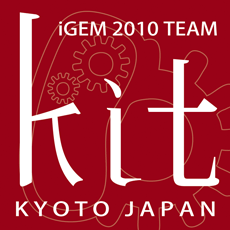Team:KIT-Kyoto/Project
From 2010.igem.org
The fireworks using AHL as a transmitter.The bacteria communicate with each other in the same way as people do so using some languages.This was called Quorum Sensing, and we paid our attention to this Quorum Sensing. In Quorum Sensing, the bacteria use the chemical substance called "autoinducer" in substitution for words to say with a human being. The bacteria confirm how much density the same type of bacteria exist by around oneself with autoinducers. When they sense the density is high, the bacteria take action all at once. We produce bioart using Quorum Sensing as materials in a colon bacillus this time. E. coli uses a chemical substance called "N-Acyl-Homoserin-Lacton(AHL)" as autoinducers. We thought whether we could reproduce fireworks by bioart using AHL as a communication factor.We use the GFP to express flower firelight.The GFP,which is fluorescence protein discovered by Aequorea victoria,has the property of forming a chromophoric group (chemical structure to develop a color) alone. For a rough procedure, fireworks are launched and turned off by the following methods. ① GFP is expressed in E.coil using AHL as a communication factor ② Turn off the expressed GFP like a chain reaction.
Slime mold has been living in various shapes its life cycle. This time we focused on the cellular slime mold, especially in the slime mold. Dictyostelium is the representative of cellular slime mold. Slime mold has a very strange life cycle. It is an organism that has characteristics of both plants and animals. Slime mold life cycle can be divided into five stages. 1st stage spore 2nd stage myxameba 3rd stage aggregate 4th stage Moving body 5th stage Myxameba Look at these five stages in detail. First, Dictyostelium is survive until conditions for spore growth.(1st stage) Then the spores grow into myxameba,and undergo cell division and multiply while eating bacteria such as E. coli and yeast. In this case, amoeba cells can move about freely, behave like animal cells, so to speak, and has been living as a unicellular organism. (2nd stage) But eliminating the food around, and go into starvation, now that the chemicals in some cells, one making a collection of 100,000 cells gather around the cell toward. This assembly is not just a collection of cells, because it has most of the features of multicellular organisms,so they can be said multicellular organisms. (3rd stage) The aggregate forms moving body (slug structure) and moves to search the good place of the condition.(4th stage) Then they moved to stop in some places ,create a structure called a fruiting body. The structure of the fruiting body is sporangia containing a lot of spores on the cells called stalk. The pattern of dead cells and secreted from the vacuole is a growing cellulose, such as fruiting plants are like animals. (5th stage) Slime mold is repeated in this lifecycle. We have focused on characteristic morphological changes of slime mold, and hope to develop a multi-step adjustment course by using morphological changes in the slime mold. As a concrete plan, at this stage, we produce a pigment to a slime mold, are examining the possibility of changing the color of the slime mold at each stage of morphological change. The above-mentioned items are the current plans of team KIT-Kyoto. There were many points that did not become clear when I did not push forward an experiment, and it was considerably conceptual act plan, but really showed rough directionality.
| ||
File:KIT-Kyoto team.png Your team picture | ||
| Team Example |
| Home | Team | Official Team Profile | Project | Parts Submitted to the Registry | Modeling | Notebook | Safety |
|---|
Overall project
Your abstract
 "
"
